Forums:
There are so many species from such a lot of genera that I thought I'd start a board that was more general - Panayoti and others have been rapping on spiny plants on the Cactus discussions and I love pricklies (although Monica doesn't so I have to keep them out of touch with one another) but above all I think thistles of all sorts are the great gems. So here's a starter pack from northern Morocco. IDs are sometimes uncertain but I think they are just so good.

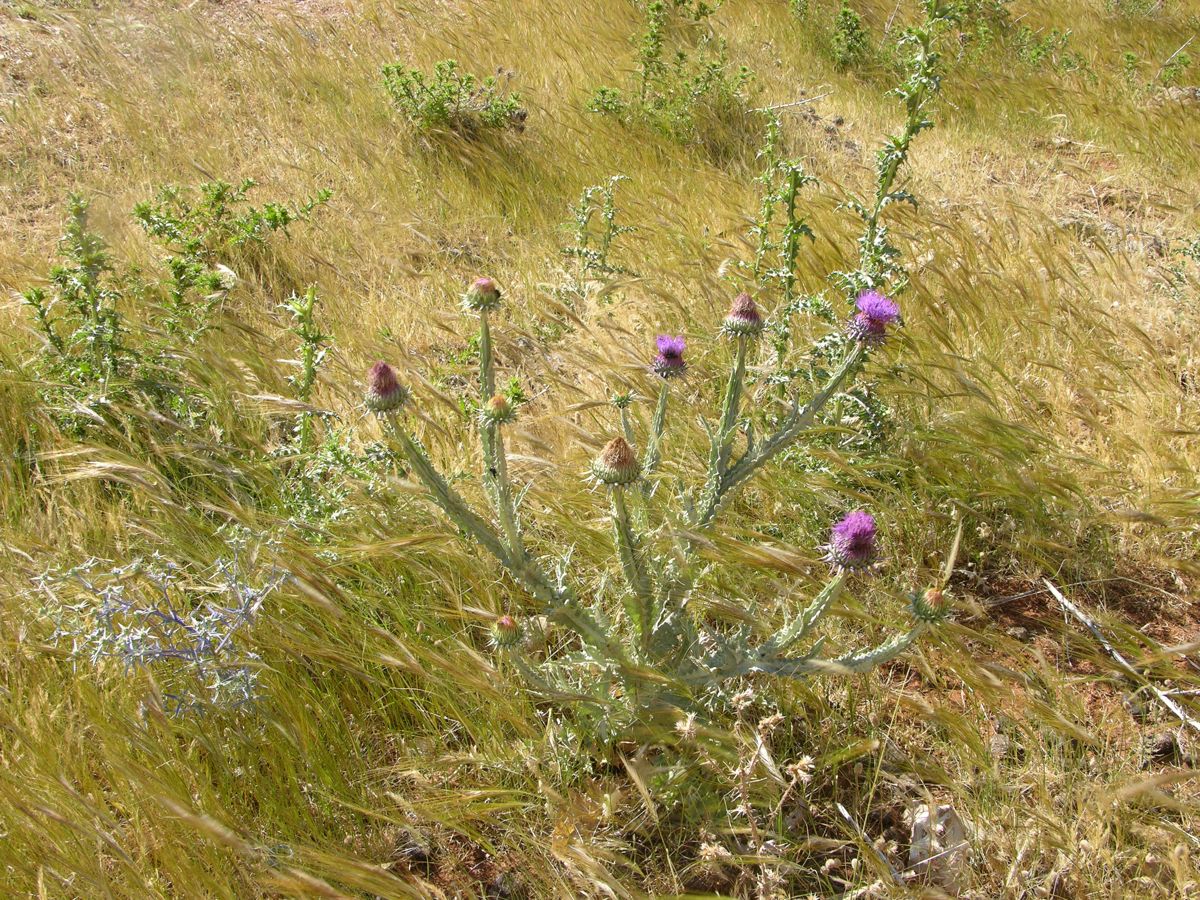
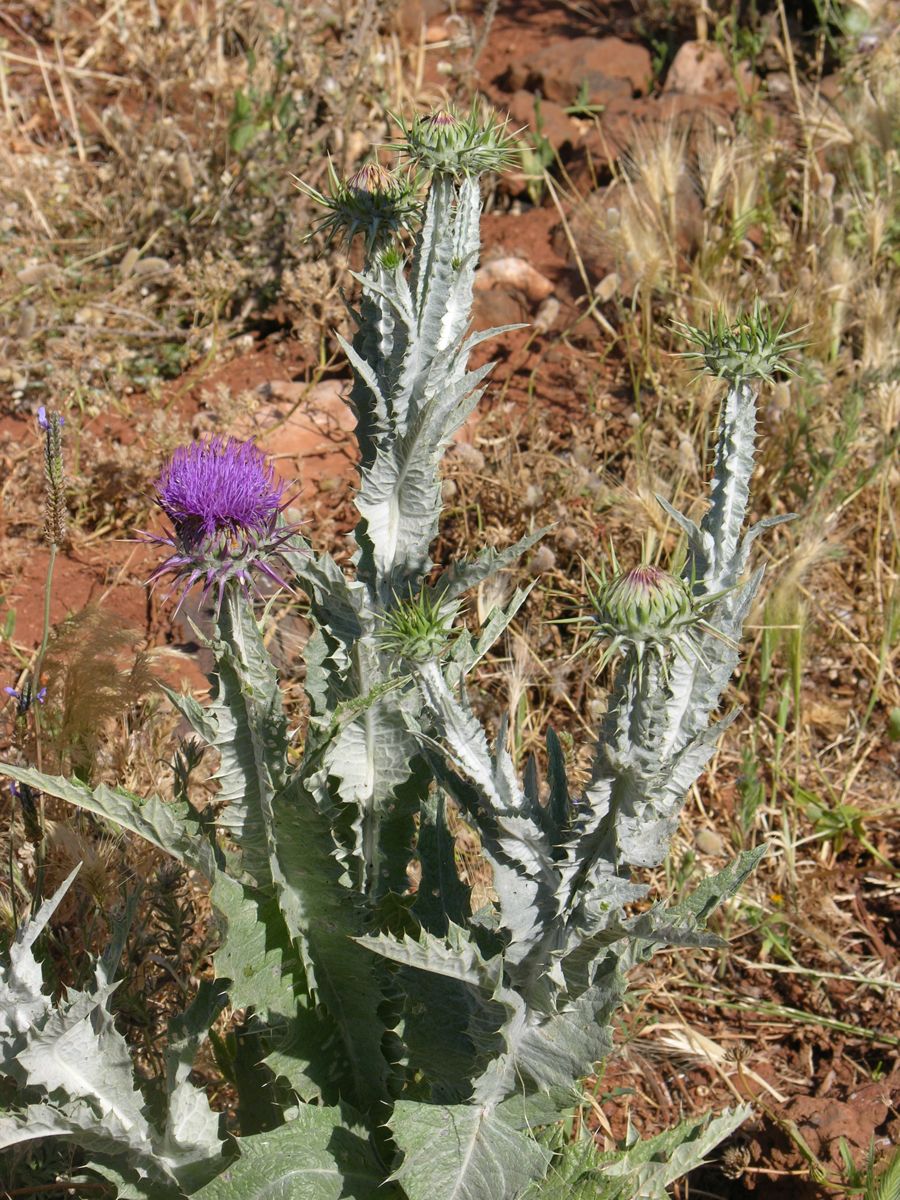

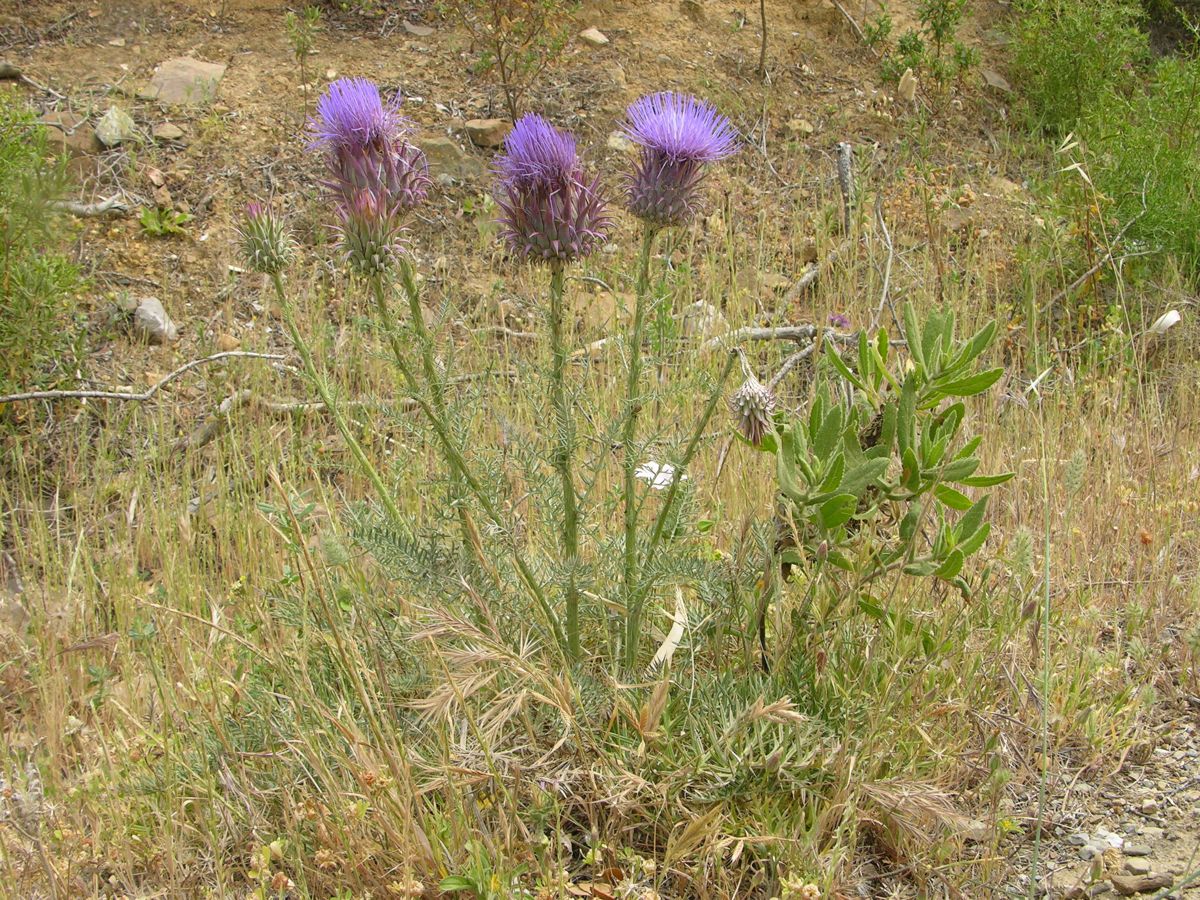
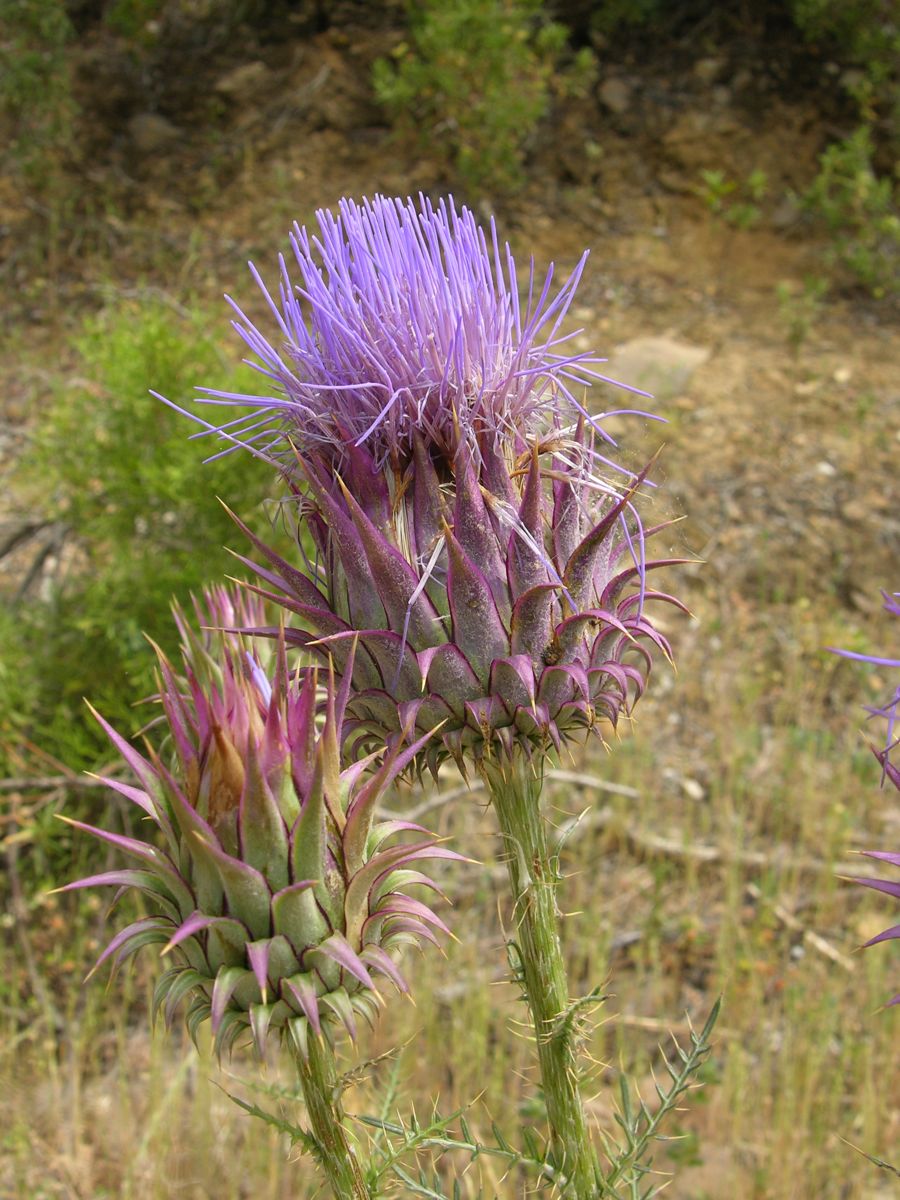
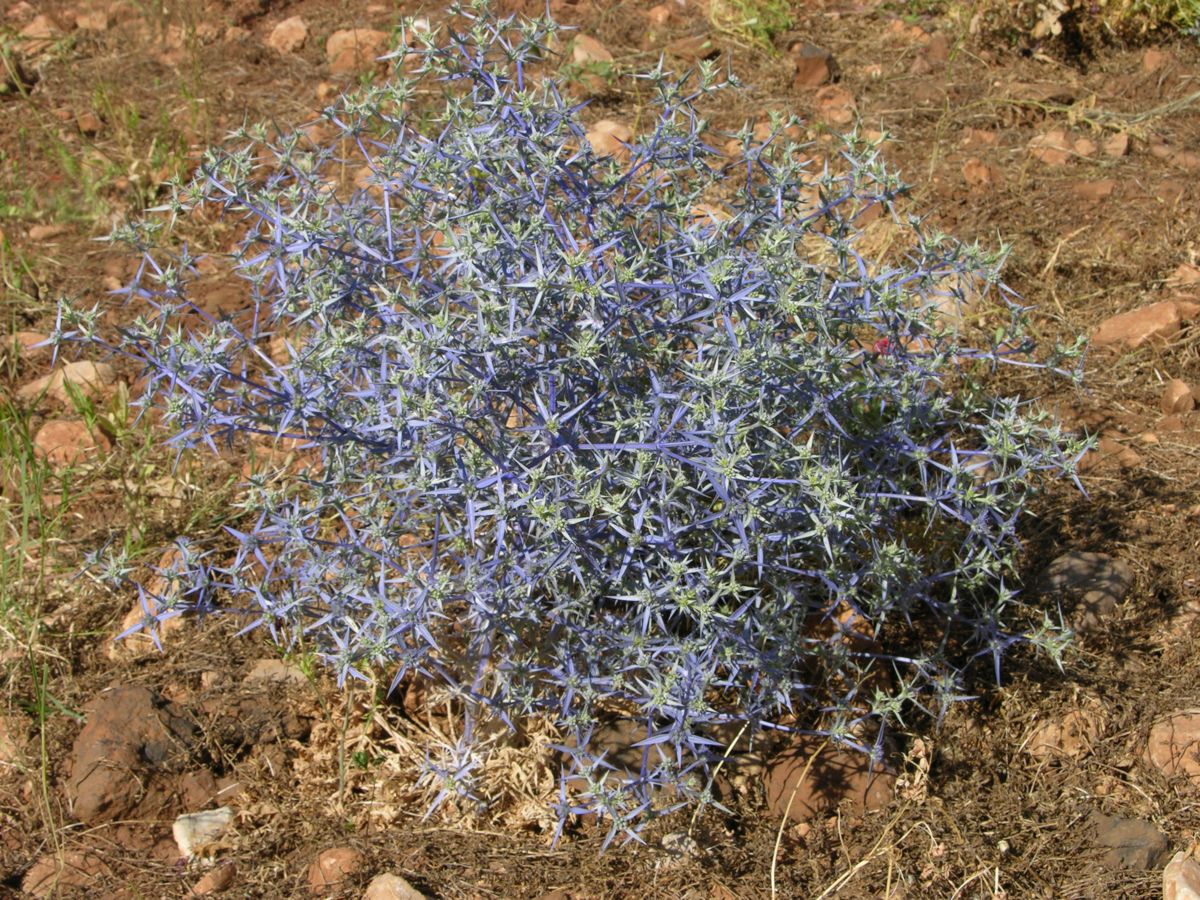
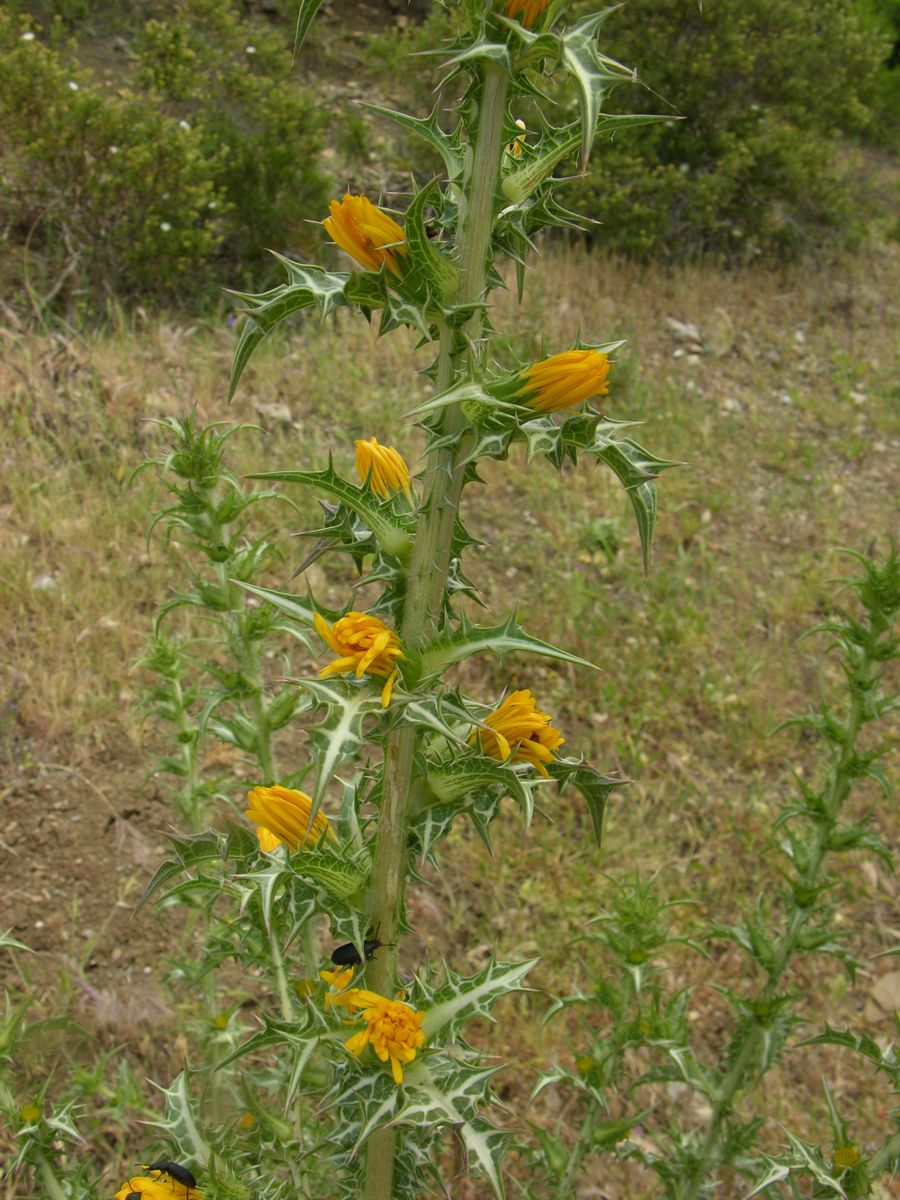
Comments
Mark McDonough
Re: Thistles
Mon, 03/08/2010 - 6:51amBeautiful architectural form on this spiny creatures; the closeup photo of Cynara shows such playful and colorful construction. I could almost make an exception on my "no-spiny-or-thorny-plants-in-my-garden" rule to grow an Eryngium like that; I wonder what species it is. Echinops are a fairly standard nursery offering here so far as perennials go; not sure what species your photo represents, but it is a beauty. As far as I'm aware, the Echinops cultivars sold as perennials are not prone to invasiveness.
One of the worst invasive pests here is Cirsium vulgare or Bull Thistle... I dig them out whenever I see them. The silky fluffy seed parachutes are a most effective means of seed dispersal as they slowly float away, perhaps for miles, in the slightest breeze.
http://www.invasive.org/species/subject.cfm?sub=3393
Googling Cynara, that's an interesting family... from the edible Globe Artichoke to several species that get used in the cheese-making process, as well as the customary invasive species, like C. cardunculus.
http://en.wikipedia.org/wiki/Cynara
Malcolm, are all of these photographed in the wild? And if so, where?
Trond Hoy
Re: Thistles
Mon, 03/08/2010 - 8:06amIf you don't like spines you can have them like this. I found it high up in Turkey. The Echinops is also from Turkey, a small island in Lake Van (an interesting salt lake in eastern Turkey).
McGregorUS (not verified)
Re: Thistles
Mon, 03/08/2010 - 8:35amHoy
Love the Carduus - a wonderful rosette although I'm afraid that the lack of prickles is a bit disappointing for me - a bit like a non-alcoholic Bloody Mary. And the Echinops is great - Lake Van - that's a place I have on my list.
Lori S. (not verified)
Re: Thistles
Mon, 03/08/2010 - 8:36amTrond, I wonder if the first might possibly be a Carduncellus? (It's rather reminiscent of Carduncellus pinnatus, which I grow).
For comparison:
http://www.nargs.org/nargswiki/tiki-browse_image.php?imageId=698
McGregorUS (not verified)
Re: Thistles
Mon, 03/08/2010 - 8:37amMark
All the photographs were taken in northern Morocco around the Rif mountains from just south of Tetouan eastwards as far as Taza.
and here is another one from the Taza area that I haven't got a genus for - if anyone can help
McGregorUS (not verified)
Re: Thistles
Mon, 03/08/2010 - 8:45amLori
That's brilliant - it looks like the picture I've just posted might be your Carduncellus which is in the north Moroccan flora. Thanks.
But your querying of Trond's Carduus made me wonder about it being an Atractylis species.
Mark McDonough
Re: Thistles
Mon, 03/08/2010 - 9:31amI remember when I subscribed to the MacPhail & Watson expedition to Turkey, one of the goal plants was Echinops emiliae, for which I received seed but no germination
There are other possibilities too, Jurinea comes to mind. One introduced by Mac&W is Jurinella moschus ssp. pinnatisectus, I believe this is still in cultivation. Just did some armchair botanizing to look as a few more of the fantastic sea urchin dwarf thistles, even Centaurea comes to mind. Here are some links, even including a couple more compact Carduus species:
Jurinea humilis
http://www.vidasilvestreiberica.org/es/content/jurinea-humilis
http://tolweb.org/onlinecontributors/app?page=ViewImageData&service=exte...
Gallery
http://sophy.u-3mrs.fr/photohtm/SI986.HTM
Jurinea subacaulis
http://www.skalnicky.cz/jpeg/Jurinea%20subacaulis.jpg
Jurinea cadmea
http://www.peterkornstradgard.se/bilder_06/jurinea_cadmea.jpg
Carduus aurosicus (most are tall, here's a couple that are more compact)
http://sophy.u-3mrs.fr/photohtm/SI524.HTM
Carduus carlinoides
http://sophy.u-3mrs.fr/photohtm/SI30015.HTM
Centaurea calcitrapa
http://sophy.u-3mrs.fr/photohtm/SI572.HTM
Trond Hoy
Re: Thistles
Mon, 03/08/2010 - 9:53amYou got me think! I have done a little "research" and Jurinella moschus ssp pinnatisecta looks very similar. (I consulted "The most beautiful flowers of Turkey" of Erdogan Tekin.)
Unfortunately I found no ripe seeds (It is from 3000m and probably hardy at least in a dry climate.)
Mark McDonough
Re: Thistles
Mon, 03/08/2010 - 10:01amJurinella moschus ssp. pinnatisecta
http://www.biologie.uni-ulm.de/fgag/Bilder/Jurinella/pages/Jurinella%20m...
http://photos.v-d-brink.eu/Flora-and-Fauna/Asia/Turkey-the-Northeastern-...
http://photos.v-d-brink.eu/Flora-and-Fauna/Asia/Turkey-the-Northeastern-...
Trond Hoy
Re: Thistles
Mon, 03/08/2010 - 10:44amWell, Mark, you are not convinced? The picture in my flora is not quite like those you show, and I don't know what's correct. It is not easy to determine a species from pictures only anyway.
Here's another I haven't name for. Suggestions? (It is from Mt Kenya)
Todd Boland
Re: Thistles
Mon, 03/08/2010 - 11:23amTrond, that is one scary thistle, whatever it is!
Mark McDonough
Re: Thistles
Mon, 03/08/2010 - 11:37amSorry Trond, I didn't give any context to my links. I believe your plant (Carduus sp?.JPG) is Jurinea or Jurinella and not a true thistle or Carduus species. A couple of the links I gave show Jurinella moschus, not ssp. pinnatisecta. There are several subspecies, it is a highly variable plant... there were some photos I found that show Jurinella moschus with entire, oval leaves, looking very different than the dissected leaf types. And there are other species too. In my opinion, the foliage tells me it is Jurinea or Jurinella.
As to your other thistle up on Mt. Kenya, that is a vicious bad boy isn't it? Did a google search and the information points to it being a Carduus. Here's a link, not sure if there is more than one species of Carduus up there:
http://wapedia.mobi/en/Natural_history_of_Mount_Kenya
"There are three genera of giant rosette plants; Carduus, Senecio and Lobelia. Carduus keniensis, the giant thistle, is endemic to Mount Kenya"
McGregorUS (not verified)
Re: Thistles
Mon, 03/08/2010 - 11:52amTrond - that really is a great thistle and there is obviously something else making some big rosettes all over the slope. Gigantism is a interesting high altitude alternative to being small like most of the plants we grow in the rock garden.
Mark McDonough
Re: Thistles
Mon, 03/08/2010 - 12:59pmYour dwarf rosette thistle from Taza area is a beauty, but I'm afarid I can't be of much help to ID it. Just spent some time trying to find flora information on Morocco, and there isn't much out there. As a consolation, I harvested some interesting photo links of prickly spiny stuff. I recommend putting your goggles on NOW: ;D
Carlina sp.
http://apl385.com/leutasch/Carline%20Thistle%20carlina%20sp.jpg
Carlina gummifera
http://www.exploringkatharo.com/largepics/Carlina%20gummifera.jpg
Centaurea raphanina ssp. raphanina
http://www.exploringkatharo.com/largepics/Centaurea%20raphanina%20ssp.%2...
Centaurea raphanina
http://www.stridvall.se/flowers/gallery/Asteraceae_2/AAAA9036
http://www.stridvall.se/flowers/gallery/Asteraceae_2/AAAA9032
Carduncellus monspeliensium
http://commons.wikimedia.org/wiki/File:Carduncellus_monspeliensium_01.JPG
And some particularly vicious pointy plants just for Malcolm ;D ;D
Carlina curetum
http://www.exploringkatharo.com/largepics/Carlina%20curetum%20ssp.%20cur...
Centaurea benedicta
http://www.exploringkatharo.com/largepics/Centaurea%20benedicta.jpg
Centaurea calcitrapa ssp. calcitrapa
http://www.exploringkatharo.com/largepics/Centaurea%20calcitrapa%20ssp.%...
Centaurea idaea
http://www.exploringkatharo.com/largepics/Centaurea%20idaea.jpg
Centaurea hyalolepis
http://www.stridvall.se/flowers/gallery/Asteraceae_2/719_40
Cirsium creticum ssp. dictaeum
http://www.exploringkatharo.com/largepics/Cirsium%20creticum%20ssp.%20di...
Cynara cardunculus
http://www.stridvall.se/flowers/gallery/Asteraceae_2/426_28
Notobasis syriaca
http://www.stridvall.se/flowers/gallery/Asteraceae_2/289_33
Ptilostemon afer
http://www.stridvall.se/flowers/gallery/Asteraceae_1/330_35
...wouldn't want to traverse this meadow...Carduus carlinoides
http://www.stridvall.se/flowers/gallery/Asteraceae_1/257_32
McGregorUS (not verified)
Re: Thistles
Mon, 03/08/2010 - 1:12pmThe Cynara cardunculus image is just stunning - and thanks for introducing me to www.stridvall.se
Maybe someone will know this species from Colorado - I'm working on the principle that he Pikes Peak pic is the same species further on and it shows the flowers are actually purple not yellow.
Trond Hoy
Re: Thistles
Mon, 03/08/2010 - 1:37pmThose rosettes are Lobelia sp. I observed at least two different species of lobelia at Mt Kenya.
Malcolm, I should like to grow more thistles if I had space for them.
Lori S. (not verified)
Re: Thistles
Mon, 03/08/2010 - 10:54pmCirsium scopulorum?
http://images.google.ca/imgres?imgurl=http://www.pikespeakphoto.com/imag...
McGregorUS (not verified)
Re: Thistles
Tue, 03/09/2010 - 1:00amCertainly looks like a good possibility Lori, thanks. I just thought it was so magnificent - bit like a snow lion - should come from Tibet really.
Mark McDonough
Re: Thistles
Tue, 07/06/2010 - 8:37pmI was sure that we'd be seeing some great thistly things here with the spiny 2010 growing season... maybe everyone is just saving up their digital photos. Watching an waiting for some prickly stuff. :D
Peter George
Re: Thistles
Wed, 07/07/2010 - 10:30amI am growing a few small thistles, Centauria drabifolia and C. achtarovii. The former has spread to about 12 inches and now has multiple flowers, while the latter grows about 4 inches tall and spreads about 6 inches or so. It throws up one bloom, which is followed by a period of dormancy, and then another bloom later in the season. Both are hardy here in Massachusetts, and both are quite beautiful if sited properly so they can be seen easily.
So far (3 years) neither has produced viable seed, but given this summer's weather (HOT) and their Turkish origins, I'm hopeful that their more prolific blooms this year will get me some seeds that will germinate.
Mark McDonough
Re: Thistles
Wed, 07/07/2010 - 10:43amBoth are terrific! Your gorgeous artistic close-up shot of C. achtarovii has me longing for that one, the the idea of a slowly spreading dwarf yellow one certain has its appeal too. Yes, the hot weather might very well induce some seed, and without the usual litany of thunderstorms to possibly ruin seed.
Peter George
Re: Thistles
Wed, 07/07/2010 - 10:46amThe C. achtarovii is a nice one, but the size of the plant and the brevity of the bloom are less impressive in real life than in a photograph. I imagine it would be more ..........impressive? in a grouping, so if possible I'm going to try to grow about 10 or so in one section of the garden. THAT would be impressive.
Robert Nold
Re: Thistles
Wed, 07/07/2010 - 11:01amYears ago I grew Centaurea urvillei ssp armata, from Czech seed. Beautiful straw colored flowers and serious spines.
I grew another one (this would have been at the time of the NARGS conference in Vail) at the same time that was labeled "sp.", which, you would think, would stand for "species", but really stood for "Spines of Death, Invisible". The effect of putting your hand into the plant (like, to see if it really had spines) was similar to putting your hand into a nest of razor blades. I dug it out.
Trond Hoy
Re: Thistles
Thu, 07/08/2010 - 1:02pmNot strictly a thistle and not very spiny but it is the best here at the moment. Sonchus asper is a weed! However, I like the succulent leaves, the flowers are not much to boast of. Here it is together with Trifolium arvense which I also appreciate although they are both annuals (Are annuals allowed here?)
Peter George
Re: Thistles
Fri, 07/09/2010 - 6:42amMy first photo of C. drabifolia was so bad I took another one which actually shows the plant, not just the flower. Here it is. Over the 2 plus years I've had it in the garden, I've had as many as 3 blooms open at one time, but right now I've got one open and one coming. Last summer it went dormant, and I was certain it was dead, but after about a month it started showing some growth, came back in September and bloomed again. It's a very nice plant.
Lori S. (not verified)
Re: Thistles
Fri, 07/09/2010 - 10:26amIt will be some time before most of the thistles are in bloom in my yard. Here's all I got right now... a couple of rosettes of Carduncellus pinnatus that popped up between some semps.
Lori S. (not verified)
Re: Thistles
Sat, 07/10/2010 - 5:16pmHere's a beauty, Cirsium eriophoroides, endemic to SE Tibet.
http://www.tibetinfor.com/tibetzt/flower/huahui_en/04/04_17.htm
Anne Spiegel
Re: Thistles
Sun, 07/11/2010 - 12:49amI grew this from seed as Jurinella (?). The 2nd part of the label is illegible. Anyone have any ideas?
John P. Weiser
Re: Thistles
Thu, 07/15/2010 - 10:47amJust noticed this thread. Great information!
I have had the farmers attitude when it comes to thistles the key work being "Weed" but that comes from dealing with Bull, Canadian, and Scotch infestations. You have opened my eyes to the many opportunities I have missed out on.
I do have a few shots of one of the tamer western North American thistles. Cirsium scariosum aka. Elk thistle. It is found growing in riparian meadows and open forest across the western half of North America. I have only seen this low form along the eastern Sierra foot hills. I know in some forms it sends up spikes of flowers in cream through pink hues.
Lori S. (not verified)
Re: Thistles
Fri, 07/16/2010 - 11:39amHere's my favourite of our native thistles, Cirsium hookerianum - Hooker's thistle.
It was not yet in bloom up on Forgetmenot Ridge yesterday, but here is a close-up of the buds (along with the biggest shield bug I've ever seen - about 3/8ths of an inch across!)
Trond Hoy
Re: Thistles
Fri, 07/16/2010 - 1:48pmWeiser, what have elks to do with hat showy thistle? They don't eat it?
Lori, a nice one to sit upon when you rest! Is monocarpic or perennial?
Lori S. (not verified)
Re: Thistles
Fri, 07/16/2010 - 1:57pmActually, I prefer cushion cacti (Escobaria vivipara) for sitting down to rest... it seems to be the best way to find them, too! ;D
Hooker's thistle is said to be biennial.
Trond Hoy
Re: Thistles
Fri, 07/16/2010 - 2:12pmI remember once in Ecuador (or was it the Atlas mountains) I sat down on a green spot among sharp rocks. I jumped several feet when the green spot stung like wasps in my buttock, the green spot was a tight-grown plant with long, sharp needles. Since I have always examined where I put the lower parts of my body.
Lori S. (not verified)
Re: Thistles
Sat, 09/11/2010 - 9:29amWhere to post, where to post? Well, I guess these are thistles...
Carlina acaulis, now open... with two bees that seem to be cuddling for warmth in our (so-often of late) cool, rainy weather!
Mark McDonough
Re: Thistles
Sat, 09/11/2010 - 1:52pmA striking specimen! It almost makes me want to relax my no-spiny-plants-in-the-garden-because-I-hate-getting-jabbed-rule ;) Here we're getting very cool nights now, and the bees appear glued to the flowers each night and well into the morning until things warm up.
Trond Hoy
Re: Thistles
Sun, 09/12/2010 - 12:32amNow I wonder, Mark. What do you call very cool nights? Here the nights are still 55-60F.
Bumblebees tolerate much colder weather than honeybees. Here bumblebees can be seen flying even if the temp is lower than 10C/50F. But these days I have more hoverflies in the flowers than either bumblebees or honeybees.
Mark McDonough
Re: Thistles
Sun, 09/12/2010 - 10:04amInto the low fifties range, was 52 F this morning. Today it is cloudy and cold, what an about face from all of the endless +90 F days, going running soon to contemplate the garden and introduce some clever dancing jig into my running style to appease the rain gods, as it is still dust-dry here even though cool temperatures.
Lori S. (not verified)
Re: Thistles
Sun, 09/12/2010 - 12:18pmIt was 0.9 deg C here overnight, according to a weather station in this neighborhood. I believe what would be considered the "official" temperature, at the airport, was 2 deg C. Brrr...
Trond Hoy
Re: Thistles
Mon, 09/13/2010 - 3:46amLow fifties is not uncommon here even in summer! Hope the rain dance works for you. I don't need to, plenty of rain here the next days.
That's what I call cool! Hope we don't experience that low before end October!
Cliff Booker
Re: Thistles
Fri, 09/24/2010 - 2:16pmA thistle pictured in Turkey ... a lovely thing.
Mark McDonough
Re: Thistles
Fri, 09/24/2010 - 2:25pmCliff, that's one dangerous brute... I'm glad they haven't invented 3D JPG images yet, I would've poked my eye out on that one. These spiny things do have amazing geometric detail, glad I can enjoy their visual intrigue on a forum rather than in the garden. Do you know what genus-species it is?
Richard T. Rodich
Re: Thistles
Fri, 09/24/2010 - 9:30pmAnd they dry very nicely...
Silybum marianum
Cliff Booker
Re: Thistles
Fri, 09/24/2010 - 11:56pmLovely image Rick.
Sorry Mark, I don't know the identity, but have attached some more images in case anyone is able to christen it (or the identity of the yellow thistle in Thistle 7)?
Mark McDonough
Re: Thistles
Tue, 03/08/2011 - 6:00amFor Malcolm :D:
I came across this Cretan endemic, Onopordum bracteatum ssp. creticum, on the "Visit West Crete" tourist web site. Some stunning close-up views of the flowers with intricate detail:
http://www.west-crete.com/flowers/onopordum_bracteatum.htm
And a strange dwarf Centaurea idaea, also endemic:
http://www.west-crete.com/flowers/centaurea_idaea.htm
cohan (not verified)
Re: Thistles
Thu, 09/06/2012 - 2:55pmLots of great spiny plants!
I hadn't got all the way through when I posted this (still haven't had a chance to follow the links)- I love them all! Cliff's Turkish spp are really amazing! The only similar thing I have so far is one Saussurea -cf leontodontoides which has wooly-not spiny- leaves not so different from some of the Centaurea, no flowers yet this year; ( I have other Sauss, but nothing thistly about them)
Here's one from my late August trip into the mountains-- this was a good sized plant, though I didn't measure- I think it was at least 40cm, a rather large plant for that site not too far below timberline; clearly no sign of flower colour, though traces of dried flowers seem darkish, maybe that indicates purple flowers?
It was a short stop so I didn't think as carefully as I might have about getting the right characters photographed for id, and did not get the phyllaries or other involucral characters.. hopefully the leaves may be enough for a tentative id- I haven't searched yet.. Lori's hookerianum does look similar??
This was on a gravel bank by the roadside between to viewpoints; as seen in the first pic; previously I have not seen much growing there apart from some prostrate Asters (didn't see them this time, but I didn't have time to walk all the way along the bank to the next stop..)
cohan (not verified)
Re: Thistles
Thu, 09/06/2012 - 3:00pmoh wow-C achtarovii just moved high on my wishlist!!